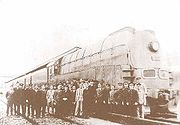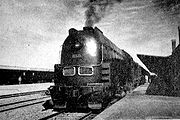railroad.wikisort.org - Train
The China Railways SL7 (Chinese: 勝利7; pinyin: Shènglì; lit. 'victory') class steam locomotive was a class of 4-6-2 express passenger steam locomotives operated by the China Railway. They were originally built for the South Manchuria Railway (Mantetsu) to pull the Asia Express[1] - Mantetsu's signature train and most iconic locomotive, whose images were used on fliers, posters, postage stamps, and even children's school textbooks, as a symbol of technology and modernism in Manchukuo and was used to demonstrate the success of Japan's imperial project.[2]
| China Railways SL7 (勝利7) Mantetsu Pashina class (パシナ) | |||||||||||||||||||||||||||||||||||||||||||||||||
|---|---|---|---|---|---|---|---|---|---|---|---|---|---|---|---|---|---|---|---|---|---|---|---|---|---|---|---|---|---|---|---|---|---|---|---|---|---|---|---|---|---|---|---|---|---|---|---|---|---|
 Builder's photo of Pashina 981. | |||||||||||||||||||||||||||||||||||||||||||||||||
| |||||||||||||||||||||||||||||||||||||||||||||||||
| |||||||||||||||||||||||||||||||||||||||||||||||||
| |||||||||||||||||||||||||||||||||||||||||||||||||
| |||||||||||||||||||||||||||||||||||||||||||||||||
History
After designing his first locomotive, the Pashiko class, at age 37 Nobutarō Yoshino (吉野信太郎), who had studied at the American Locomotive Company for two and a half years and, as the young star of Mantetsu's engineering division, nicknamed "King of Locomotives",[3] designed the streamlined Pashina class was built with the specific purpose of hauling the long-distance, high-speed Asia Express limited express train between Dalian and Xinjing (Changchun), at speeds up to 120 km/h (75 mph).[1] It was one of the world's first steam locomotives to be fully streamlined,[4] which reduced air resistance by 30%,[3] and they were painted a distinctive Prussian blue colour.[4] Design and manufacture of the Pashina class took only seven months, using a novel process of simultaneous design and manufacture.[3] A group of American reporters who rode the inaugural "Asia Express" train,[5] doubting that the Japanese could build such a locomotive, enquired as to which American manufacturer had built the locomotive for Mantetsu. After Yoshino replied that he had designed it, and that it had been built domestically using components sourced almost entirely from Japan and Manchukuo, the reporter asked which American university he and the other engineers had studied at, he answered that most had studied in Japan, but that many had gained experience in the US.[3]
They were the first Mantetsu locomotives to be fitted with the Schmidt type E superheater, and were also equipped with a combustion chamber firebox, a feedwater heater, and an automatic stoker; the stoker was deemed essential, as it was calculated that human power could not supply the necessary quantities of coal fast enough.[5] The tender bogies were fitted with Timken roller bearings. A Pashina class locomotive was used to pull Prince Chichibu's train when he visited Manchukuo in 1940. Following the suspension of the Asia Express in February 1943, they were used on ordinary express trains.
The first three were built by Mantetsu's Shahekou Works in 1934, with the next eight coming from Kawasaki in Japan, with パシナ979 (later パシナ10), completed on 21 October 1934, being the 1,500th steam locomotive to be built by Kawasaki.[4] After experiments in the Kawanishi Aircraft Company's wind tunnel, the shape of the streamlining was redesigned, and the final unit, number 981 (later パシナ12) was built with the new design by Kawasaki in 1936.
Originally numbered パシナ970 through パシナ981, they were renumbered パシナ1–パシナ12 in Mantetsu's 1938 general renumbering.[1]
| Owner | Class & numbers (1933–1938) | Class & numbers (1938–1945) | Builder |
|---|---|---|---|
| Mantetsu | パシナ970–972 | パシナ1–パシナ3 | Shahekou Works |
| Mantetsu | パシナ973–980 | パシナ4–パシナ11 | Kawasaki |
| Mantetsu | パシナ981 | パシナ12 | Kawasaki |
Postwar
All twelve survived the Pacific War and at the end of the war were assigned to the Dalian depot, and were subsequently taken over by the Republic of China Railway. After the establishment of the People's Republic and the current China Railway, they were designated class ㄆㄒ7 (PX7) in 1951, becoming class SL7 (勝利, Shènglì, "victory") in 1959; they were numbered within the 751–770 range. They remained in use on the Shenda Line between Dalian and Shenyang into the 1980s. Several locomotives were converted to a standard type because the cover of the locomotives are obstructive to inspect.[6]
SL7 753[6]-755 were noted to be in dump around Sujiatun Locomotive Depot in 1980s.[7]SL7 751 was restored to fully working condition in 1984, and is displayed at the Shenyang Railway Museum. In 2001, the restoration of SL7 757 was completed in Dalian, and it has been on display at the Shenyang Railway Museum since 2013.
Gallery
References
- Ichihara, Yoshizumi, 写真集南満洲鉄道 (South Manchuria Railway Photo Collection) pp. 119-120, 135, 1998 Seibundo Shinkosha Publishing Co. Ltd. (in Japanese)
- Louise Young. Japan's Total Empire. Berkeley: University of California Press, 1998. pp.246-7.
- 特急「あじあ」の機関車設計者は「キング・オブ・ロコモ」と呼ばれた男だった… (in Japanese)
- 1934年(昭和9年) パシナ形蒸気機関車979号が当社製造蒸気機関車の1,500両目となる (in Japanese)
- "満州写真館 特急あじあ (in Japanese)". Archived from the original on 2017-03-02. Retrieved 2017-03-01.
- "SL7(パシナ)形蒸気機関車(改造後) (in Japanese)". Archived from the original on 2016-06-18. Retrieved 2017-10-03.
- SL7 751 to SL7 770 _Railography : Chinese Locomotive Lists
Другой контент может иметь иную лицензию. Перед использованием материалов сайта WikiSort.org внимательно изучите правила лицензирования конкретных элементов наполнения сайта.
WikiSort.org - проект по пересортировке и дополнению контента Википедии



